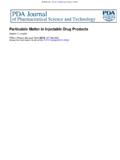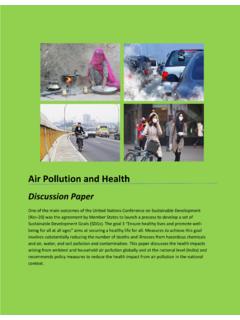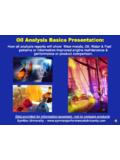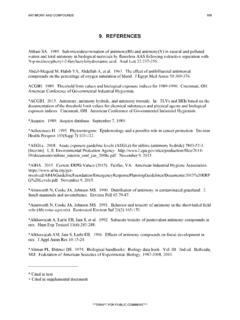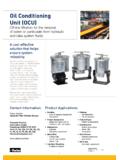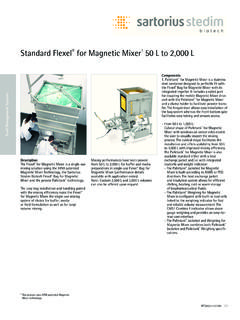Transcription of Cover by D.Meissner WHO/GRA
1 Cover by WHO/GRA World Health Organization 2010 All rights reserved. Publications of the World Health Organization can be obtained from WHO Press, World Health Organization, 20 Avenue Appia, 1211 Geneva 27, Switzerland (tel.: +41 22 791 3264; fax: +41 22 791 4857; e-mail: Requests for permission to reproduce or translate WHO publications whether for sale or for noncommercial distribution should be addressed to WHO Press, at the above address (fax: +41 22 791 4806; e-mail: The designations employed and the presentation of the material in this publication do not imply the expression of any opinion whatsoever on the part of the World Health Organization concerning the legal status of any country, territory, city or area or of its authorities, or concerning the delimitation of its frontiers or boundaries.))
2 Dotted lines on maps represent approximate border lines for which there may not yet be full agreement. The mention of specific companies or of certain manufacturers products does not imply that they are endorsed or recommended by the World Health Organization in preference to others of a similar nature that are not mentioned. Errors and omissions excepted, the names of proprietary products are distinguished by initial capital letters. All reasonable precautions have been taken by the World Health Organization to verify the information contained in this publication. However, the published material is being distributed without warranty of any kind, either expressed or implied.
3 The responsibility for the interpretation and use of the material lies with the reader. In no event shall the World Health Organization be liable for damages arising from its use. These Guidelines were adopted by the WHO Expert Committee on Biological Standardization at its 59th meeting which took place in Geneva from 13 to 17 October 2008 and will be published in the WHO Technical Report Series. iii Contents 1. 1 2. List of abbreviations and definitions 2 3. General 7 Historical 7 The use of serum versus plasma as source material .. 7 antivenom purification methods and product 7 Pharmacokinetics and pharmacodynamics of 8 Need for national and regional reference venom preparations.
4 8 4. Epidemiological 8 4,1 Global burden of snakebites .. 8 Main 9 5. Worldwide distribution of venomous 10 Taxonomy of venomous 10 Medically important venomous 13 Minor venomous snake species .. 15 Sea snake 16 Main 16 6. Antivenoms design: selection of snake 17 Selection and preparation of representative venom 17 Manufacture of monospecific or polyspecific 17 Main 19 7. Preparation and storage of snake 19 Production of snake venoms for immunization .. 20 Staff responsible for handling snakes .. 25 Main 26 8.
5 Quality control of 27 Records and 27 National reference materials .. 28 Characterization of venom 28 Main 28 9. Overview of the production process of 29 10. Selection and veterinary health care of animals used for production of 31 Quarantine period .. 31 Veterinary surveillance and vaccinations .. 31 Animal health surveillance after inclusion in the herd .. 31 Main 32 iv 11. Immunization regimens and use of 33 Animals used in antivenom production .. 33 Venoms used for 34 Preparation of venom 34 Detoxification of venom .. 35 Immunological 35 Preparation of immunogen in adjuvants.
6 35 Immunization of animals .. 36 Traceability of the immunization 38 Main 39 12. Collection and control of animal plasma for 39 Health control of the animal prior to and during bleeding 40 Premises for blood or plasma 40 Blood or plasma collection 40 Labelling and identification .. 40 42 Control of plasma prior to fractionation .. 43 Main 43 13. Purification of immunoglobulins and immunoglobulin fragments in the production of 44 Good manufacturing practices .. 44 Purification of the active substance .. 44 Pharmacokinetic and pharmacodynamic properties of IgG, F(ab')2 and 55 Main 56 14.
7 Control of infectious 56 56 Risk of viral contamination of the starting plasma .. 57 Viral validation of manufacturing 57 Viral validation studies of antivenom 61 Production-scale implementation of process steps contributing to viral 65 Transmissible spongiform 66 Main 67 15. Quality control of 68 68 antivenom reference 73 Main 73 16. Stability, storage and distribution of 73 73 Storage .. 74 Distribution .. 74 Main 74 v17. Preclinical assessment of 75 Introduction .. 75 Essential assay for preclinical testing of antivenoms: prevention of 76 Additional recommended assays for preclinical testing of 76 Development of alternative assays to replace murine lethality 79 Limitations of preclinical 79 Main 80 18.
8 Clinical assessment of 80 80 Clinical studies of 81 Post-marketing 83 Main 85 19. Role of national regulatory 85 Impact of good manufacturing 86 Establishment licence and 86 Authors and 88 92 Appendix 1 Worldwide distribution of medically important venomous 102 Appendix 2 Summary protocol of manufacturing and control of snake antivenom 132 WHO Guidelines for the Production, Control and Regulation of Snake antivenom Immunoglobulins 11 INTRODUCTION The unavailability of effective snake antivenom immunoglobulins (antivenoms) to treat the specific types of snakebite envenomings encountered in various regions of the world has become a critical health issue at global level.
9 The crisis has reached its greatest intensity in sub-Saharan Africa, but other regions, such as south-east Asia, are also suffering from a lack of effective and affordable products. The complexity of the production of antivenoms, in particular the importance of preparing appropriate snake venom mixtures for the production of hyperimmune plasma (the source of antivenom immunoglobulins), the decreasing number of producers and the fragility of the production systems in developing countries further jeopardize the availability of effective antivenoms in Africa, Asia, the Middle East and South America. Most of the remaining current producers are located in countries where the application of quality and safety standards needs to be improved.
10 In October 2005, the WHO Expert Committee on Biological Standardization (ECBS) recognized the extent of the problem and asked the WHO Secretariat to support and strengthen world capacity to ensure long-term and sufficient supply of safe and efficient antivenoms. In March 2007, snake antivenom immunoglobulins were included in the WHO Model List of Essential Medicines (1), acknowledging their role in a primary health care system. Urgent measures are needed to support the design of immunizing snake venom mixtures that can be used to make the right polyspecific antivenoms for various geographical areas of the world. Sustainable availability of effective and safe antivenom immunoglobulins should be ensured and production systems for these effective treatments should be strengthened at global level.










